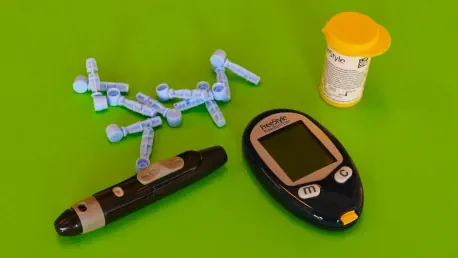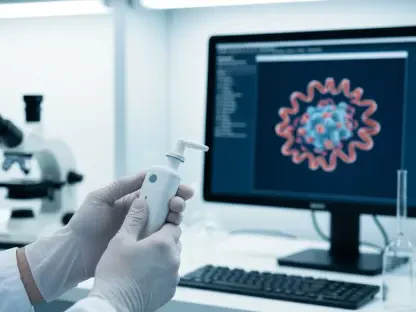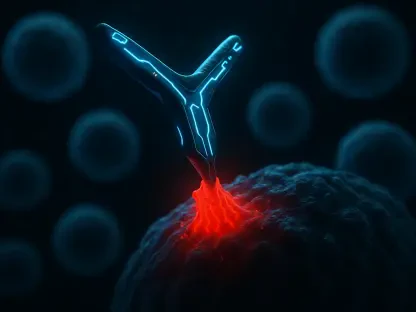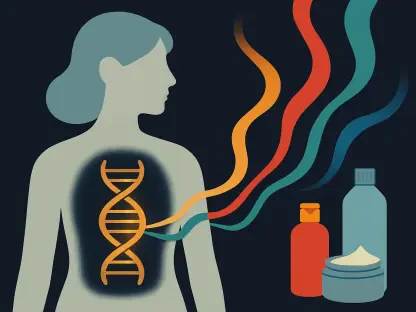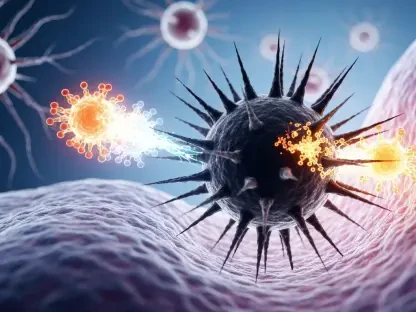Glucose, a simple sugar widely recognized for its role as the primary energy source for most living cells, has recently been discovered to play a critical role beyond its conventional function. In groundbreaking research conducted by a team at Stanford Medicine, glucose has been identified as a significant regulator of tissue differentiation, a finding that challenges existing paradigms about cellular biology and opens new potential pathways for treating various conditions, including cancer and diabetes.
New Insights into Glucose
Beyond Energy Provision
The conventional understanding of glucose has long been centered on its primary role as an energy source, fueling cellular activities through its breakdown. However, this recent study disrupts that long-held belief by revealing that glucose exerts a regulatory function in tissue differentiation. This process occurs not through its metabolic breakdown but rather through its ability to bind directly to proteins that are responsible for regulating the transcription of genetic information into functional proteins. This new understanding highlights glucose as a pivotal molecule in cellular differentiation, significantly broadening its biological importance.
This discovery was particularly striking because it presented glucose as an influencer of cell specialization processes. The protein-binding mechanism implies that glucose can directly modulate the transcriptional landscape of differentiating cells, thereby influencing their identity and function. This contradicts the previously held notion that glucose’s primary role was limited to its energy-supplying capabilities, revealing a dual role that could have profound implications for understanding tissue formation and regeneration.
Unexpected Discoveries
The research team, led by experts Khavari and Lopez-Pajares, embarked on their investigation without the intention of studying glucose specifically. Their goal was to identify biomolecules that governed the process of cellular differentiation. Through the use of mass spectrometry and high-throughput screening, they cataloged the variations in biomolecular composition as skin stem cells differentiated into mature keratinocytes. To their surprise, glucose emerged as one of the most elevated molecules during this differentiation process.
This discovery was contrary to their expectations, as the differentiation process typically involves a reduction in cellular division and a corresponding decrease in energy demand. The elevated levels of glucose during this process suggested that glucose was playing an unexpected, non-metabolic role in cell differentiation. This serendipitous finding prompted the researchers to further investigate the broader implications of glucose’s presence and its newfound role in cellular specialization.
Uncovering Differentiation Mechanisms
Confirming the Patterns
To substantiate their findings, the research team employed a variety of techniques that confirmed the rise in glucose levels during differentiation. They used fluorescent and radioactive glucose analogs as well as biological sensors to track glucose levels and distributions within cells. These approaches validated the initial observations, revealing consistent patterns in multiple human cell types, including fat, bone, and white blood cells, as well as genetically engineered mice.
The consistency of these results across different cell types and organisms indicated a fundamental role for glucose in regulating tissue differentiation. It suggested that glucose’s role as a regulator of differentiation was not an isolated phenomenon but rather a widespread and critical aspect of cellular biology. This broadened the scope of the research, emphasizing the importance of glucose in regulating various cellular processes beyond organ-specific contexts.
Import and Export Dynamics
One of the critical observations from the study was the dynamics of glucose import and export within cells. The increased levels of glucose during differentiation were attributed to heightened import and reduced export of glucose, rather than increased metabolic consumption. This indicated that glucose accumulation within the cells was a controlled process aimed at supporting differentiation. Experiments further demonstrated that when glucose levels were kept low in engineered human skin organoids, proper differentiation was impaired.
Over 3,000 genes involved in skin differentiation showed altered expression due to low glucose levels. However, when an analog of glucose that could not be metabolized was introduced, differentiation processes resumed, reinforcing the idea that glucose’s role in differentiation is independent of its energy-providing function. This underscores the hypothesis that glucose acts as a signaling molecule in these contexts, crucial for gene expression and cellular specialization.
Health Implications
Historical Hints Validated
Historical observations have long hinted at the potential regulatory role of glucose in cell differentiation. For instance, embryonic stem cells have been known to lose their differentiation potential in high-glucose environments, implying that glucose might influence differentiation capabilities. Additionally, clinical observations in diabetic patients have shown impairments in wound healing and tissue regeneration, conditions intrinsically tied to cell differentiation processes.
The new findings from the Stanford study align with these historical hints but provide a mechanistic understanding of how glucose might influence differentiation. By validating these historical observations, the study offers new insights into the potential for glucose to have broader physiological and pathological effects. This enriched understanding may pave the way for novel therapeutic approaches aimed at improving tissue regeneration and addressing differentiation-related impairments in diabetic and other metabolic disorders.
Therapeutic Potential
The potential implications of these findings extend into the realm of therapeutic research. Preclinical and clinical trials have already explored the use of glucose analogs as anticancer therapies, operating on the principle of starving cancer cells by cutting off their energy supply. However, the new insight into glucose’s role in differentiation suggests that these glucose analogs might also induce differentiation in immature cancer cells. This could offer a novel treatment approach by promoting the maturation of cancer cells, thereby reducing their malignancy and improving treatment outcomes.
These findings open up promising avenues for the development of treatments aimed at reprogramming immature or undifferentiated cells in various diseases, including cancers. By leveraging glucose’s regulatory role in cell differentiation, new therapeutic strategies could be designed to target the differentiation pathways, thus offering a dual approach to both inhibit cancer cell growth and promote healthy tissue regeneration.
Mechanistic Revelations
Gameplay with Transport Proteins
An important aspect of the study’s revelations was the role of glucose transporter proteins in regulating glucose levels within cells. The increased glucose levels observed during differentiation were linked to elevated production of glucose transporter proteins, facilitating greater glucose influx. Once inside the cells, glucose exhibited its regulatory role by binding to various proteins, including IRF6, which is known to influence gene expression related to differentiation.
This binding ability of glucose to transcriptional regulators like IRF6 underscores its importance as a signaling molecule within the cells. It suggests a mechanism where glucose does more than serve as a fuel; it actively participates in the complex regulation of gene expression and cellular specialization. This highlights a nuanced and multifaceted role for glucose that extends beyond metabolic functions, positioning it as a critical component of cellular signaling networks.
Signaling Dynamics
One of the most profound implications of this study is the concept of glucose serving as a broadcast signal within cells. By binding to numerous regulatory proteins, glucose effectively triggers a widespread cellular response, akin to how a fire alarm triggers a coordinated emergency response. This perspective fundamentally changes how glucose is perceived in the context of cell biology, from being merely a source of energy to being a critical messenger that coordinates complex biochemical pathways.
Understanding glucose’s signaling dynamics provides a deeper insight into its role in cellular biology. It prompts a re-evaluation of how metabolic and signaling pathways intersect and influence each other. This new understanding has the potential to revolutionize the approach to studying cellular processes and developing interventions for diseases where these processes go awry.
Research Directions and Future Prospects
Expanding Research Horizons
The revelations from this study set the stage for further research into the diverse roles of glucose in cellular regulation. Future investigations could delve deeper into glucose’s regulatory mechanisms across various tissues and disease models, exploring how glucose dysregulation contributes to pathological conditions. By mapping out these pathways, researchers can uncover new therapeutic targets and strategies to correct differentiation defects and improve tissue regeneration.
Additionally, understanding the nuances of glucose’s role in healthy tissue differentiation could lead to advancements in regenerative medicine and stem cell therapy. By manipulating glucose levels or mimicking its regulatory effects, it may be possible to enhance the efficiency of stem cell differentiation and tissue repair, offering promising avenues for treating injuries and degenerative diseases.
Re-evaluating Fundamental Biology
The findings from the Stanford study compel the scientific community to reconsider established beliefs about glucose’s role in health and disease. This groundbreaking revelation about glucose’s dual function as both an energy source and a regulator of tissue differentiation suggests that metabolic processes are intricately linked with regulatory pathways governing cell function and differentiation. This new perspective encourages further exploration and re-evaluation of other metabolites and their potential signaling roles.
Future studies can leverage these insights to develop innovative therapeutic approaches for complex medical conditions, fostering a deeper integration of metabolic and cellular biology in disease research. By continuing to explore glucose’s multifaceted role, the scientific community can develop a more comprehensive understanding that bridges the gap between metabolism and cellular regulation.
Conclusion
The Stanford Medicine study led by Khavari and Lopez-Pajares heralded a significant advancement in the understanding of cell biology by revealing glucose’s previously unknown role as a key regulator of tissue differentiation. This discovery necessitates a reevaluation of glucose’s functions, extending beyond its traditional role as an energy source to include its critical role as a signaling molecule. The insights gained from this study pave the way for novel therapeutic strategies targeting cellular differentiation pathways and hold promise for transforming treatment approaches for various conditions, including cancer and diabetes. As research continues to build on these foundations, it is likely that even more significant discoveries and innovative treatments will emerge.
Funding and Acknowledgements
Glucose, a well-known simple sugar, serves as the primary energy source for most living cells. However, recent groundbreaking research from Stanford Medicine has revealed that glucose’s role extends far beyond merely providing energy. This study has identified glucose as a significant regulator of tissue differentiation, challenging long-held beliefs in cellular biology. This discovery is pivotal, as it could lead to new treatment options for various conditions such as cancer and diabetes. By uncovering glucose’s regulatory role in tissue differentiation, scientists are now exploring innovative pathways to combat these diseases. This research opens the door to potentially groundbreaking therapeutic strategies that could revolutionize how we approach these challenging health issues. Such insights are considered extremely promising for advancing medical science, offering hope for significant improvements in health care interventions and patient outcomes in the future.
